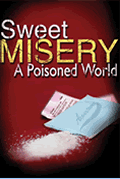HOW
SYSTEMIC ENZYMES WORK TO CURE DISEASES
PART
1 of 2
By Dr. James
Howenstine, MD.
March 17, 2009
NewsWithViews.com
Aging appears to begin between the ages of 27 and 35 when the production of enzymes that dissolve protein begins to diminish. Enzymes are widely recognized for their importance in digesting food. They also break up circulating immune complexes in the blood. Enzymes can act to prevent too much fibrin from being deposited in wounds, fractures and joints. These enzymes also remove necrotic debris and excess fibrin from the blood stream. Immune system regulation can also be accomplished with enzymes. Most of the development of systemic enzyme therapy was carried out in the Far East and Europe. Enzyme therapy is a prime example of a situation in which US medicine is missing the boat due to a lack o of awareness of what the rest of the world is doing and our unwillingness to use therapies not made by “big pharma.” Enzymes can not be patented so they are of little interest to drug companies.
The proteolytic enzymes used in enzyme therapy dissolve fibrin. When strong proteolytic enzymes are in an enzyme preparation, they can be powerful enough in their action to actually gradually digest scar tissue away. This takes time to occur, of course, but eventually all the scar tissue may disappear.
Sometimes when the body deposits excess fibrin in a tissue the tendon sheaths become thickened and the free movement of a tendon back and forth fails to occur with the tendon getting caught in the fibrous tissue (e.g. trigger finger, Dupytron’s contracture of the palm, etc.) and failure of normal function occurs. Tissues containing excess fibrin are weak because they do not provide adequate space for the epithelial tissue that normally grows through the whole fibrin matrix, producing strength.
These tissues with excess fibrin have restricted motion if joints are involved and will have diminished size and function if the scarring involves an internal organ(e.g. heart after infarction, kidney after a clot to a kidney artery, pancreas after episode of pancreatitis, etc.)
Systemic enzymes have a unique feature. Side effects do not occur with systemic enzymes. This means that raising the dosage to massive levels does not cause any problems unlike pharmaceutical drugs. The initial dosage, which is often one potent enzyme pill three daily taken 45 minutes before or 45 minutes after a meal, can be raised by three tablets daily every few days until the desired therapeutic response develops.. A person given more than 3700 enzyme tablets in one day experienced only diarrhea from this massive capsule intake.
A second interesting facet of systemic enzymes is that their effects on coagulation intensify the actions of blood thinning drugs like coumadin. Fibrin digests with enzymes which dissolves blood clots.Persons on anti-coagulant drugs and individuals with hemophilia may have more intense bleeding with enzyme therapy, and should avoid using enzymes.
Use of Vitalzym in Disease Conditions
Vitalzyme + is an enzyme formulation that contains protease, serrapeptase, papain, bromelain, amylase, lipase, rutin and amia, which is a rich source of vitamin C. Serrapeptase is a unique proteolytic enzyme isolated from non-pathogenic enterobacteria Serratia E 15 that has superior anti-inflammatory action[1] when compared to other proteolytic enzymes. Serrapeptase is the enzyme found in the intestine of the silkworm that permits the silkworm to break out of the cocoon.
In
addition to breaking down fibrin deposits, Vitalzyme+ reduces
inflammation, removes and filters viruses from the blood, balances the
immune system, and removes toxins from the blood.
The systemic effects of enzymes can be used to prevent and resolve many
diseases. The rutin contained in Vitalzym has valuable properties.
Rutin is a bioflavinoid which composes 4-6% of buckwheat. Rutin
strengthens and controls the permeability of blood vessels and
capillary walls. This turns weak blood vessels into strong ones that
are less likely to bleed. Rutin lowers the blood pressure and slows
aging.
Bioflavinoids, such as rutin, quercitin, and hesperidin, are powerful
antioxidants that effectively combat free radicals believed to cause
90% of diseases(cancer, arteriosclerosus, arthritis, aging etc.) Other
enzyme formulations such as Nattokinase, Lumbrokinase, and Wobenzym
contain potent enzymes such as chymotrypsin which make them very
effective.
Many articles have been written recently extolling the virtues of serrapeptase. Serrapeptase has anti-inflammatory, anti-edema, and fibrinolytic properties. A study in otolaryngological patients from many centers in Italy disclosed that serrapeptase was very effective in alleviating thick infected secretions.[2] Ninety one percent of those taking serrapeptase reported good to excellent results compared to 22% in the control subjects. Knee cartilage operations were followed by 50% less swelling[2] in the group of patients taking serrapeptase. Patients with fibrocystic breast pain[3] reported 85% marked to moderate improvement compared to 65% not receiving serrapeptase. Twenty patients (average age 39) with carpal tunnel syndrome[4] were given 10 mg of serrapeptase twice daily. Thirteen of these were better with electrophysiologic proof of recovery.
Enzyme Therapy In Malignancies
In Europe, therapy of malignancies usually includes enzymes in large dosage which has lengthened survival. Enzyme preparations are carefully formulated so they are able to avoid dissolving in stomach acid and thus are available to get into the blood without being destroyed.
In cancer cases, the cancer cells are surrounded by a layer of fibrin which may be up to 15 times thicker than the layer of fibrin that surrounds normal cells. This fibrin layer permits these malignant cells to escape destruction by killer immune cells, which are unable to detect the cancer cell antigens. The systemic enzymes are able to remove this fibrin coating, permitting the immune cells to again kill the tumor cells. Additionally, immune cells become stimulated by enzymes to increase the production of tumor necrosis factor which can attack tumor cells, as well as cells infected by viruses. This is vital to cancer defense. Systemic immune therapy has prolonged life for many patients, and in the case of cancer of the pancreas, Dr. Wyba states that about one-third of cases have been cured using Wobenzyme. The enzymes must not be stopped or the cancer recurs. The dose may need to be as much as 30 pills three times daily. We think it may be wise to include enzymes along with other therapies in treating cancer.
Enzyme Therapy in Infections
The human body reacts to infections by increasing the viscosity of the blood. This slows the flow of blood and increases the clotting tendency of the blood. At times, the clotting tendency is so exaggerated in infections, malignancies and other disease states that there is widespread occurrence of fibrin clots all over the body (disseminated intravascular coagulation). In this state, all of the blood’s substances that are needed to cause the blood to clot become consumed, resulting in no ability to clot. This leads to widespread hemorrhagic are at the same time there is a multitude of clots. Systemic enzyme therapy stops the clotting tendency of blood that occurs in infections by its action to dissolve fibrin. There is an increased risk of heart attacks and strokes immediately after acute infections (Chlamydia, Cocksackie viruses, etc.) and in persons suffering from gingivitis.
Viral and Bacterial Infections
Many infectious problems that trouble humans come to light when a dormant virus becomes activated after residing harmlessly for many years. A good example of this is herpes zoster skin infection developing in patients who had recovered from an old chicken pox viral infection (varicella zoster) many years previously. Herpes viruses may lie dormant for many years, only to produce very painful neuritis at a later date.. This may follow an acute illness or any event that injures the immune system(chemotherapy).
When a virus contacts a human cell, the external coating connects to the cell, and the virus becomes able to contact DNA. This connection to DNA permits the virus to reproduce in a rapid manner. Proteolytic enzymes consume the exterior coating of a virus rendering the virus permanently inert. To recover from a viral infection requires that enough enzymes be taken to get ahead of the rapid viral replication within cells, This may require 5-10 capsules of Vitalzyme + three times daily or more.
Biofilm Protection for Bacterial Infection Involving Prosthetic Substances
One of the problems plaguing medicine currently is infection of prosthetic substances placed in the body(prosthetic hips, knees, heart valves. etc.) These infected prosthetic parts often need to be replaced, as their infection can not be eliminated. Bacteria are able to create a biofilm that prevents antibiotic drugs from reaching and killing them. A similar problem exists in heart valve infections, where frequently an emergency replacement of an infected valve leaflet becomes the only way to save the patient’s life. The proteolytic enzyme serrapeptase was shown to enhance the killing activity of the antibiotic Ofloxin in cultures and to prevent the formation of biofilms.[5] This prevention of biofilms could become very valuable in treating these problem infections.
Enzyme Therapy in Allergic Diseases
There is an inflammatory component to the asthmatic attack. Use of enzymes during an acute episode should be effective therapy in many persons. Decreasing the volume of secretions and causing the secretions to become less viscous so they could be easier to cough up is also beneficial. Maintaining a low dosage of enzymes, 2-3 capsules daily, should also create an environment in which it would be more difficult for a new attack of asthma to get started.
The allergenic pollens irritating the nose in allergic rhinitis(hay fever) cause the production of considerable mucous secretions. Taking enzymes should decrease the volume of these secretions and thus alleviate the symptoms. As in asthma, taking 2-3 enzyme capsules daily could prove valuable by making it more difficult for hay fever symptoms to be initiated.
Use of Enzymes in Painful Conditions
Proteolytic enzymes are able to block the release of pain producing amines from tissues that have inflammation. This elimination of pain benefits many conditions. The disability of migraine headaches can usually be helped by enzyme therapy. Sinus headaches can be alleviated by enzymes, which decrease and liquefy secretions that contribute to the pain. A group of 59 patients with acute and chronic sinusitis were assigned to receive either the enzyme bromelain or placebo along with conventional therapy (antibiotics, decongestants, etc.) The group getting bromelain seemed to improve because it dissolved fibrin leading to improved absorption of edema fluid, thus enabling greater penetration of immune system components. Obviously, one of the more valuable uses for enzymes is to relieve the pain in arthritic conditions, bursitis, and synovitis.
Lung Disease and Enzyme Therapy
Pulmonary Fibrosis: In pulmonary fibrosis the thin, filmy, alveolar membrane, which permits oxygen to enter the bloodstream and enables carbon dioxide to pass from the blood into the lung air spaces , becomes progressively thickened by the laying down of fibrin deposits on the alveolar membrane. These thickened alveoli do not permit normal oxygen for carbon dioxide exchange in the lung. Shortness of breath then appears with exertion.
Many disease states can cause a chest x-ray appearance identical with that of pulmonary fibrosis. These conditions include cancer, infections, inhaled irritants(asbestosis, silicosis, beryllium, etc.), sarcoidosis, diseases of connective tissue (lupus, rheumatoid arthritis, scleroderma), and adverse drug reactions (more than 50 can cause fibrosis including 14 chemotherapy drugs, sulfa, penicillin, furadantin, hydralazine, aprèsaline, gold, chlorpropamide, allopurinol, hydrochlorthiazide, and dilantin). Standard therapy for pulmonary fibrosis includes courses of cortisone and immunosuppressive drugs (Imuran etc.) if cortisone fails to benefit.
Since pulmonary fibrosis has progressive scarring and an inflammatory reaction in the alveoli, therapy with systemic enzymes that digest fibrotic tissue and block the inflammatory reaction should be a safe rational approach. Vitalzym + is helping patients with pulmonary fibrosis. Start with 3 capsules three times daily on an empty stomach and raise the dosage at regular intervals until improvement is noted.
Sarcoidosis A disease of unknown cause, sarcoidosis is more common in Afro-American than Caucasians. The disease causes nodules and scarring in the involved organs, Sarcoidosis is often discovered by a routine chest xray revealing shadows in an adult with no symptoms. The lung is the most common organ involved with the disease but the eyes, skin, nervous system, bones, and joints may also be involved.
Lung symptoms may include cough, shortness of breath and wheezing. When the lung symptoms are advanced or the disease involves critical structures(eyes, nervous system) cortisone therapy is usually effective. Often it is impossible to discontinue cortisone, which may need to be maintained in low dosage.
A promising therapy for sarcoidosis is systemic enzymes for a trial period of 2-3 months. The inflammatory granulomas and scar tissue(fibrosis) in the lung, eyes, bones, joints and skin might very well be terminated by this therapy which is much safer than cortisone. Regular increase in enzyme dosage will reach levels where resolution of fibrosis can occur.
Use of Enzymes in Arthritic Diseases
Enzymatic therapy can benefit all forms of arthritis by reducing inflammation, alleviating pain, and stopping the circulation of inflammation causing immune complexes. For these reasons many arthritis products contain enzymes(bromelain,papain, etc.) Wherever there is pain there is inflammation which can be blocked by enzymes.
|
Subscribe to the NewsWithViews Daily News Alerts! |
Systemic Lupus Erythematosus
A key
feature of SLE is allergic reactions in body tissues (auto-immunity).
Circulating immune complexes are routine, and the sites where they
deposit determine the symptoms of this disease, (lining membranes
overlying lung, heart, abdomen, joints, brain, skin, etc,) A trial of
systemic enzymes could remove these circulating immune complexes from
the blood of the SLE patient.
Several months of enzyme therapy might have a dramatically beneficial
effect on the disease. High dosage initially is a good idea. For part
two click below.
Click here for part -----> 2,
Footnotes:
1,
Mazzone A. et al Evaluation of serratia peptidase in acute or chronic
inflammation of otolaryngogo;y pathology: A multi-cetre, double-blind,
randomized trial versus placebo. J
Int Med Res 1990, 379-88
2,
Esch PM, et al Reduction of postoperative swelling objective
measurement of the upper ankle joint in treatment with serrapeptase
------- A prospective study (German) Fortschr
Med. 1989; 107(4)67-8, 71-2
3,
Kee WH et al The treatment of breast engorgement with serrapeptase (Danzen)
a randomized double blind controlled trial Singapore
MJ 1989; 48-54
4,
Panaguriya A., et al A preliminary trial of serrapeptase in patients
with carpal tunnel syndrome. J
Assoc Physician India;
47(12):170-172
5,
Selan
L et al Protolutic Enzymes: A new treatment strategy for prosthetic
infections? Antimicro Agents Chemother, 1993;37(12):2618-21
© 2009 Dr. James Howenstine - All Rights Reserved





















